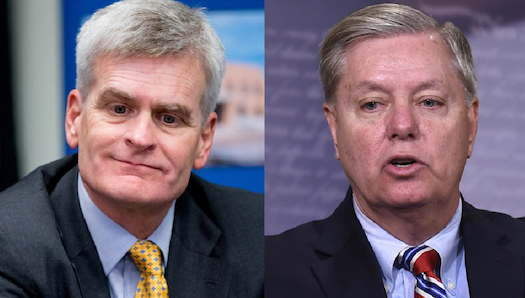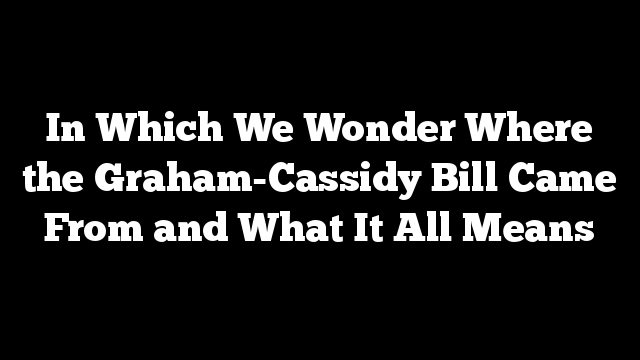
The latest Republican attempt to repeal and replace the ACA looks a lot like what they were trying to do in May, June and July—and failed to do.
But actually, the framing of the current effort—the Graham-Cassidy bill—is much more deeply grounded in the perennial debate over where political power resides in the U.S.: the federal government or the states. Graham-Cassidy also more starkly reflects what many conservatives are trying to achieve in health care policy. And what they are trying to achieve is, to put it euphemistically, not nice.
On both counts, this renewed debate resonates politically beyond health care. It’s no coincidence that the two Senators behind this new push, Lindsey Graham and Bill Cassidy, are from southern states—South Carolina and Louisiana, respectively. Before the Civil War, during the Civil War, and up to the present day, southern conservatives like Graham and Cassidy—more passionately than their northern counterparts—have pushed to devolve power to the states and weaken the federal government.
Conservatives in the western states have, for their own set of reasons, come to fiercely embrace this philosophy, too—broadly called federalism.
A new book—“Democracy in Chains—The Deep History of the Radical Right’s Stealth Plan for America” by Nancy MacLean explores the southern roots of modern conservatism, with a spin that is chilling in the context of the current health care debate. (An excellent review of the book by Sam Tanenhaus in the July-August issue of “The Atlantic” is my source.)
MacLean argues, according to Tanenhaus, that southern conservative philosophy has been and still is deeply grounded in the idea that government does not and should not exist to “foster dependency” in the population, initiate programs to help the poor or middle class, or reflect majority rule. Indeed, the majority can’t and shouldn’t even be trusted.
Rather, government’s role is to maximize individual freedom and liberty. Moreover, says Tanenhaus, government’s “misguided Good Samaritanism by helping the unlucky cushions them against the consequences of their bad choices.”
This was exactly the sentiment, Tanenhaus writes, of the House Republican who explained his vote to gut the ACA and remove pre-existing condition protections by saying the House bill aimed in part to “reduce the cost to those people who lead good lives.”
As we have all gleaned, the great health care debate of 2017 is about more than health care. It is about power, very differing political philosophies, moral and ethical principles, the role of government, and I would also say—simply—good and evil.
Good and evil as they are embodied in political philosophy and the struggle for power, and government policies.
The conservative approach probed in “Democracy is Chains” reflects the evil impulses of human nature and a belief system that opposes government’s role as a benefactor, force to reduce inequality, or redistribute income.
That does not mean, of course, that all conservative ideas, conservatives or Republicans are evil. Nor does it mean that all progressives, liberal ideas and aspirations, and Democrats are all good. Human nature, social organization, culture and political systems are complex, to put it mildly.
But, Graham-Cassidy, even more than its predecessor bills, exudes the worst (evil and inhumane) impulses and ideas that reside in the conservative approach to health care that has emerged this year.
As has been widely reported in recent days, it would reduce the number of people with insurance and government funding for health care for low and middle-income people. It would dramatically shift the health care policy path we’ve been on since 1965.
Graham-Cassidy’s framework of devolving power over health care design and decision-making to the states vastly overreaches, creating chaos and harm to consumers. And it uses state flexibility as the proverbial wolf uses a sheep’s sheared fleece as he sneaks up on the flock.
The balance of health care power between the feds and states is a delicate and complex system that has evolved over years. While far less than perfect and somewhat Rude Goldberg (Medicaid!), the system has a certain stability. Upending it in one fell swoop, even if phased in, is beyond dangerous.
That said, there is merit is exploring more state flexibility, as moderate conservatives like Stuart Butler (now at Brookings; google his writings) have pushed for years.
As readers of THCB know, the ACA contained a mechanism for that—in section 1332. Bipartisan deliberations in the Senate HELP committee, underway now, to stabilize the ACA marketplaces for 2018 and 2019 are exploring changes to Section 1332 to allow states more leeway to experiment.
A stake should be driven through the heart of Graham-Cassidy’s—befitting the evil it represents. The HELP committee’s deliberations should be the priority as 2018 open enrollment fast approaches.
